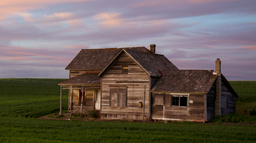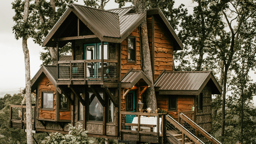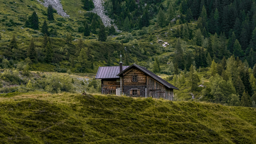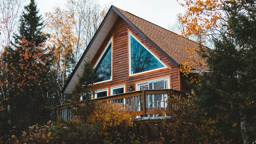Sometimes even the peaceful cabin surroundings can’t dissuade you from gazing around your home-away-from-home and mentally moving walls, updating appliances and laying new surfaces.
Don’t worry; it’s just a case of Cabin Update Fever. Although there isn’t a cure, we have four remedies for the most popular remodeling projects. These tips will give you a better idea of what jobs you can tackle yourself, what you might want to hire out and what those price tags might read.
INSTALLING NEW FLOORS
Wood flooring has come a long way, and it’s not just the ease of tongue-and-groove flooring with click installation. It used to be a wood floor project would keep you, and all your furnishings, out of a room for nearly two weeks as stains dried and finishes cured. Now that same project, using prefinished wood flooring, can have you back enjoying that space in a weekend.
Depending on the product you purchase and the condition of your existing floor, the planks can be glued, floated, nailed or stapled down over an existing wood, vinyl, concrete or sub-floor with minimal prep. Installation is a relatively easy do-it-yourself project, but be prepared for lots of bending and knee-time. If you’re going to hire the task out, figure an additional $2 to $4 or so per square foot.
The tools for the job are basic ones (varying slightly per method of installation), including a miter saw, jigsaw and a flexible blade saw like a flush-cut dovetail saw. If you’re stapling or nailing, you can rent a floor stapler with an air compressor or a pneumatic hardwood nailer for about $30 a day.
Flooring options run the gamut from the very affordable – laminates starting around $1.50 per square foot – to the high-end options available at about $4 to $7. There are also engineered woods designed for long wear (which start at $6 per square foot) and natural products like bamboo and cork that run from $7 to $12 per square foot.
While you can’t beat the price of a laminate, a low-end product will become worn looking in about 10 years of typical use – and some tend to be loud under foot. This selection can be just fine for a low trafficked weekend home; however, if your cabin is busy year round, you might be better off with a quality engineered wood product that can yield five decades of wear. Likewise, high-pressure laminates have a 30- to 50-year lifespan.
Engineered wood flooring is constructed with multiple layers of wood, making it less vulnerable to shifting or cracks caused by seasonal moisture that you’ll see in some solid wood flooring. These products are available in lots of different styles and finishes including hand-scraped versions that contour each plank for a rustic look. Also, unlike a plastic laminate, most engineered wood can be re-sanded and finished to its original beauty a couple of times, making its cost of $6 - $9 a square foot a relative bargain.
When shopping for flooring, don’t overlook the engineered cork options, which start around $7 per square foot. In addition to being a sustainable product (harvesting does not harm the cork tree, which lives to be harvested again), cork floors inhibit the growth of mold and insects. And those sleeping below and in the open loft will thank you for the natural sound dampening inherent to cork.
It’s a good idea to order flooring samples before you buy; this allows you to bring them home for color matching, etc. Whatever product you go with, be sure to order 10 percent more than you need to account for cuts and waste. Also, let the planks acclimate to the humidity in your cabin for at least three days at moderate temperatures/humidity before you begin your project.
Wood flooring has come a long way, and it’s not just the ease of tongue-and-groove flooring with click installation. It used to be a wood floor project would keep you, and all your furnishings, out of a room for nearly two weeks as stains dried and finishes cured. Now that same project, using prefinished wood flooring, can have you back enjoying that space in a weekend.
Depending on the product you purchase and the condition of your existing floor, the planks can be glued, floated, nailed or stapled down over an existing wood, vinyl, concrete or sub-floor with minimal prep. Installation is a relatively easy do-it-yourself project, but be prepared for lots of bending and knee-time. If you’re going to hire the task out, figure an additional $2 to $4 or so per square foot.
The tools for the job are basic ones (varying slightly per method of installation), including a miter saw, jigsaw and a flexible blade saw like a flush-cut dovetail saw. If you’re stapling or nailing, you can rent a floor stapler with an air compressor or a pneumatic hardwood nailer for about $30 a day.
Flooring options run the gamut from the very affordable – laminates starting around $1.50 per square foot – to the high-end options available at about $4 to $7. There are also engineered woods designed for long wear (which start at $6 per square foot) and natural products like bamboo and cork that run from $7 to $12 per square foot.
While you can’t beat the price of a laminate, a low-end product will become worn looking in about 10 years of typical use – and some tend to be loud under foot. This selection can be just fine for a low trafficked weekend home; however, if your cabin is busy year round, you might be better off with a quality engineered wood product that can yield five decades of wear. Likewise, high-pressure laminates have a 30- to 50-year lifespan.
Engineered wood flooring is constructed with multiple layers of wood, making it less vulnerable to shifting or cracks caused by seasonal moisture that you’ll see in some solid wood flooring. These products are available in lots of different styles and finishes including hand-scraped versions that contour each plank for a rustic look. Also, unlike a plastic laminate, most engineered wood can be re-sanded and finished to its original beauty a couple of times, making its cost of $6 - $9 a square foot a relative bargain.
When shopping for flooring, don’t overlook the engineered cork options, which start around $7 per square foot. In addition to being a sustainable product (harvesting does not harm the cork tree, which lives to be harvested again), cork floors inhibit the growth of mold and insects. And those sleeping below and in the open loft will thank you for the natural sound dampening inherent to cork.
It’s a good idea to order flooring samples before you buy; this allows you to bring them home for color matching, etc. Whatever product you go with, be sure to order 10 percent more than you need to account for cuts and waste. Also, let the planks acclimate to the humidity in your cabin for at least three days at moderate temperatures/humidity before you begin your project.
ADD A ROOM
While many home improvements are natural do-it-yourself projects, adding a new room is not for the novice. No doubt that a skilled do-it-yourselfer can pull off a room addition, but being realistic about the time commitment is the first consideration.
One remodeling veteran, who has been in the business approximately 30 years, says that an average room addition includes 40 major tasks beginning with drawing up professional plans and walking the permit gauntlet and ending with final inspections and lawn restoration. That comes to about 1,000 hours after adding up timecards for the contractor, carpenters, plumbers, HVAC mechanics, electricians, tilers and insulators.
Assuming you decide against DIY, the next question on your mind is, “What is this going to cost me to hire this out?” If you’re going to have professional tradespeople do your remodel, you’ll have to get them out to your cabin to evaluate the specifics. No one likes to estimate site unseen, but you can approximate $100 per square foot for a rough starting point. Of course, many projects with high-end fixtures and appliances can run over that figure, while others can dip below through the use of salvaged materials and with the cabin owners doing the low-skill tasks themselves.
Your best bet to a successful professional remodel may be to hire a general contractor – after thoroughly vetting contractor referrals with sources such as local lumberyards, friends and neighbors and the Better Business Bureau. Another good resource is the non-profit organization, the National Association of the Remodeling Industry on the Web at www.nari.org. Its website can direct you to certified professionals in your area and provide useful information on contract “must-haves” and budgeting tips. And don’t be shy about asking for references from your contractor; you’re entering into a long-term commitment with a lot of money and your cabin’s value on the line.
Once you’ve followed up on three or four contractor finalists, invite each of them out to bid on the project. Use this opportunity to ensure he/she is familiar with the building codes and regulations in your area. This is especially important for structures near bodies of water, which often carry additional zoning hurdles and protections. Surely, the most expensive remodeling job is the one you must redo to satisfy building codes.
While many home improvements are natural do-it-yourself projects, adding a new room is not for the novice. No doubt that a skilled do-it-yourselfer can pull off a room addition, but being realistic about the time commitment is the first consideration.
One remodeling veteran, who has been in the business approximately 30 years, says that an average room addition includes 40 major tasks beginning with drawing up professional plans and walking the permit gauntlet and ending with final inspections and lawn restoration. That comes to about 1,000 hours after adding up timecards for the contractor, carpenters, plumbers, HVAC mechanics, electricians, tilers and insulators.
Assuming you decide against DIY, the next question on your mind is, “What is this going to cost me to hire this out?” If you’re going to have professional tradespeople do your remodel, you’ll have to get them out to your cabin to evaluate the specifics. No one likes to estimate site unseen, but you can approximate $100 per square foot for a rough starting point. Of course, many projects with high-end fixtures and appliances can run over that figure, while others can dip below through the use of salvaged materials and with the cabin owners doing the low-skill tasks themselves.
Your best bet to a successful professional remodel may be to hire a general contractor – after thoroughly vetting contractor referrals with sources such as local lumberyards, friends and neighbors and the Better Business Bureau. Another good resource is the non-profit organization, the National Association of the Remodeling Industry on the Web at www.nari.org. Its website can direct you to certified professionals in your area and provide useful information on contract “must-haves” and budgeting tips. And don’t be shy about asking for references from your contractor; you’re entering into a long-term commitment with a lot of money and your cabin’s value on the line.
Once you’ve followed up on three or four contractor finalists, invite each of them out to bid on the project. Use this opportunity to ensure he/she is familiar with the building codes and regulations in your area. This is especially important for structures near bodies of water, which often carry additional zoning hurdles and protections. Surely, the most expensive remodeling job is the one you must redo to satisfy building codes.
A BETTER KITCHEN
Kitchen remodels are the most popular upgrade, which makes sense, as the kitchen is the heart of the cabin. Fortunately, remodeling not only improves the busiest place in the cabin, real estate association numbers show you’ll recoup much of the financial outlay – up to 98 percent – when you’re ready to sell.
Of course, anyone who was forced to wash supper dishes in the shallow bathroom sink during a kitchen remodel can tell you it’s frustrating to cut off the cabin’s main artery, maybe for weeks depending on the scale of your project. To speed up springing your appliances out of purgatory, careful planning is key.
First things first, you’ll need to figure out the scope of your project and with that, your budget. For just a few thousand dollars, you could replace your countertops, sink and faucet and reface cabinetry with new doors and hardware. This will yield significant impact for the money, but this plan only works if you like the present layout of your kitchen and your cabinet boxes are solid.
You’ll pocket about $30 a foot (around $600 for an average kitchen) if you install the countertops yourself. It’s a weekend job for someone who is comfortable taking precise measurements and using basic tools like a jigsaw, drill and belt sander for tasks such as smoothing the backs of countertops to get a good fit against the wall.
But if you’re trying to cure storage issues or create more workspace for food prep, you may wish to enlarge your kitchen by overtaking underused spaces within your cabin. The complexity of the project, along with the price, goes up exponentially from here.
Cost calculators to help with budget planning are available at www.contractors.com/h/index.html and from Consumer Reports, www.consumerreports.org.
Prices vary considerably depending on what part of the country you live in, but a moderate kitchen redo with new cabinetry and appliances starts in the $15,000 zone and goes up (and up) from there.
Once you’ve determined a figure you can live with, set aside an additional 20 percent to account for unforeseen costs. Surprises happen as old walls and floors are opened up for construction exposing vent pipes, previous shoddy craftsmanship, mold problems or other quandaries.
Even if you choose to use professionals, you could still cut down expenses by approximately 25 percent by being your own general contractor (GC).
Of course, taking on the role of researching and hiring subcontractors such as plumbers, electricians and carpenters and precisely organizing the timing of their work is an enormous task. It requires strong organizational skills, knowledge of home building and the fortitude to make tough decisions. Last, but not least, you have to be at or near your cabin during the project. If you lack in any of these areas, hiring a good GC can be worth every dime.
While the process may seem harrowing, a trip to your local kitchen showroom or home center can inspire you beyond the dust and chaos to your rewarding end – a beautiful and functional kitchen you and your guests will enjoy everyday for years to come.
Kitchen remodels are the most popular upgrade, which makes sense, as the kitchen is the heart of the cabin. Fortunately, remodeling not only improves the busiest place in the cabin, real estate association numbers show you’ll recoup much of the financial outlay – up to 98 percent – when you’re ready to sell.
Of course, anyone who was forced to wash supper dishes in the shallow bathroom sink during a kitchen remodel can tell you it’s frustrating to cut off the cabin’s main artery, maybe for weeks depending on the scale of your project. To speed up springing your appliances out of purgatory, careful planning is key.
First things first, you’ll need to figure out the scope of your project and with that, your budget. For just a few thousand dollars, you could replace your countertops, sink and faucet and reface cabinetry with new doors and hardware. This will yield significant impact for the money, but this plan only works if you like the present layout of your kitchen and your cabinet boxes are solid.
You’ll pocket about $30 a foot (around $600 for an average kitchen) if you install the countertops yourself. It’s a weekend job for someone who is comfortable taking precise measurements and using basic tools like a jigsaw, drill and belt sander for tasks such as smoothing the backs of countertops to get a good fit against the wall.
But if you’re trying to cure storage issues or create more workspace for food prep, you may wish to enlarge your kitchen by overtaking underused spaces within your cabin. The complexity of the project, along with the price, goes up exponentially from here.
Cost calculators to help with budget planning are available at www.contractors.com/h/index.html and from Consumer Reports, www.consumerreports.org.
Prices vary considerably depending on what part of the country you live in, but a moderate kitchen redo with new cabinetry and appliances starts in the $15,000 zone and goes up (and up) from there.
Once you’ve determined a figure you can live with, set aside an additional 20 percent to account for unforeseen costs. Surprises happen as old walls and floors are opened up for construction exposing vent pipes, previous shoddy craftsmanship, mold problems or other quandaries.
Even if you choose to use professionals, you could still cut down expenses by approximately 25 percent by being your own general contractor (GC).
Of course, taking on the role of researching and hiring subcontractors such as plumbers, electricians and carpenters and precisely organizing the timing of their work is an enormous task. It requires strong organizational skills, knowledge of home building and the fortitude to make tough decisions. Last, but not least, you have to be at or near your cabin during the project. If you lack in any of these areas, hiring a good GC can be worth every dime.
While the process may seem harrowing, a trip to your local kitchen showroom or home center can inspire you beyond the dust and chaos to your rewarding end – a beautiful and functional kitchen you and your guests will enjoy everyday for years to come.
DECKED OUT
Building a deck is one of those do-it-yourself projects that can really make financial sense. Generally it is not a highly skilled task, but it is labor intensive – so it will cost you either time or money. Hiring a professional can triple the price of a deck project over materials alone, which is money you could use for a larger, nicer deck. If you can wield a circular saw, shovel and a plumb bob, you could build a basic deck in a long weekend. (There are good step-by-step instructions available at www.doityourself.com.) Also worth exploring are floating foundation systems, specially cast concrete blocks that act as piers, which eliminate some of the trickier tasks of the job.
There are times to consult a pro. If you’re replacing a deck and find moisture where it attaches to the cabin, things can get complicated. A little discoloration may be okay, but if the sheathing – the layer of plywood or pressboard that covers the exterior frame – is rotten, it’s a good idea to remove it. Then, to check for further damage, jam a screwdriver into the rim joist – the lumber that runs along the outer foundation walls and to which the floor joists are nailed. If your tool penetrates over a quarter an inch into the rim joist, you’ll probably need to replace it. That’s a big job for which you may need expert advice.
But let’s assume all is well. Before you get out your post digger, remember to investigate codes and setbacks in your area that may affect the number and configuration of piers needed for a deck. Next consider how you’ll use your deck space. Arrange your outdoor furniture, grill and sun bathing chairs in the space and mark the area off with a garden hose to determine the square footage. You can also do this with one of the many addictive computer landscape design software packages available ($20 -$70 at www.amazon.com). Some programs allow you to upload a house photo and add design elements such as pergolas, wet bars and hot tubs to your deck structure. One such software program is Better Homes and Gardens Landscaping and Deck Designer 7.0.
The materials from which you construct your deck are another big consideration. Depending where you are in the country, you can expect to pay around $10 per square foot for treated lumber such as pine. But don’t forget to add in the costs of sealing, staining and replacing rotten boards for years to come. It’s worth checking out the recent improvements in composite wood products. Price-wise, these plastic and wood blends rival the cost of redwood at $18 to $23 per square foot, but offer a no-skid, low-maintenance surface that is resistant to fading.
When you feel the symptoms of Cabin Update Fever coming on, your best bet is to do some research. Fluids and rest may help too.
Building a deck is one of those do-it-yourself projects that can really make financial sense. Generally it is not a highly skilled task, but it is labor intensive – so it will cost you either time or money. Hiring a professional can triple the price of a deck project over materials alone, which is money you could use for a larger, nicer deck. If you can wield a circular saw, shovel and a plumb bob, you could build a basic deck in a long weekend. (There are good step-by-step instructions available at www.doityourself.com.) Also worth exploring are floating foundation systems, specially cast concrete blocks that act as piers, which eliminate some of the trickier tasks of the job.
There are times to consult a pro. If you’re replacing a deck and find moisture where it attaches to the cabin, things can get complicated. A little discoloration may be okay, but if the sheathing – the layer of plywood or pressboard that covers the exterior frame – is rotten, it’s a good idea to remove it. Then, to check for further damage, jam a screwdriver into the rim joist – the lumber that runs along the outer foundation walls and to which the floor joists are nailed. If your tool penetrates over a quarter an inch into the rim joist, you’ll probably need to replace it. That’s a big job for which you may need expert advice.
But let’s assume all is well. Before you get out your post digger, remember to investigate codes and setbacks in your area that may affect the number and configuration of piers needed for a deck. Next consider how you’ll use your deck space. Arrange your outdoor furniture, grill and sun bathing chairs in the space and mark the area off with a garden hose to determine the square footage. You can also do this with one of the many addictive computer landscape design software packages available ($20 -$70 at www.amazon.com). Some programs allow you to upload a house photo and add design elements such as pergolas, wet bars and hot tubs to your deck structure. One such software program is Better Homes and Gardens Landscaping and Deck Designer 7.0.
The materials from which you construct your deck are another big consideration. Depending where you are in the country, you can expect to pay around $10 per square foot for treated lumber such as pine. But don’t forget to add in the costs of sealing, staining and replacing rotten boards for years to come. It’s worth checking out the recent improvements in composite wood products. Price-wise, these plastic and wood blends rival the cost of redwood at $18 to $23 per square foot, but offer a no-skid, low-maintenance surface that is resistant to fading.
When you feel the symptoms of Cabin Update Fever coming on, your best bet is to do some research. Fluids and rest may help too.
Lucie Amundsen, a shelter writer and essayist, has made it through her own kitchen remodel and lived to write about it.
 John Wollwerth, dreamstime.com
John Wollwerth, dreamstime.com  Chuck Keeler Jr., courtesy Flynn Construction, Inc.
Chuck Keeler Jr., courtesy Flynn Construction, Inc.  Chuck Keeler Jr., photos courtesy Flynn Construction, Inc.
Chuck Keeler Jr., photos courtesy Flynn Construction, Inc.  Natalia Vainshtein, dreamstime.com
Natalia Vainshtein, dreamstime.com  Susan Leggett, dreamstime.com
Susan Leggett, dreamstime.com 









